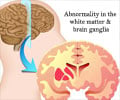Children diagnosed with autism have more gray matter in their brains, says a study that used a novel imaging technique to analyse brain structure.
The brain area, which was examined in the study, governs social processing and learning by observation. Autism is a brain development disorder that impairs social interaction and communication, and causes restricted and repetitive behavior, all starting before a child is three years old.The study, led by Manzar Ashtari, Ph.D., from the Children’s Hospital of Philadelphia in Pennsylvania, suggested that the inability of autistic children to relate to people and life situations in an ordinary way may be the result of an abnormally functioning mirror neuron system.
“Our findings suggest that the inability of autistic children to relate to people and life situations in an ordinary way may be the result of an abnormally functioning mirror neuron system,” Ashtari said.
Mirror neurons are brain cells that are active both when an individual is performing an action and experiencing an emotion or sensation, and when that individual witnesses the same actions, emotions and sensations in others.
The study found that the autistic children had increased gray matter in brain regions of the parietal lobes implicated in the mirror neuron system.
In the study, 13 male patients diagnosed with high-functioning autism or Asperger syndrome and an IQ greater than 70 and 12 healthy control adolescents were examined. Average age of the participants was about 11 years.
Advertisement
By adding ABM to DTI, the researchers can detect subtle regional or localized changes in the gray matter. In addition to the gray matter abnormalities linked to the mirror neuron system, the results of the study also revealed that the amount of gray matter in the left parietal area correlated with higher IQs in the control group, but not in the autistic children.
Advertisement
The autistic children also evidenced a significant decrease of gray matter in the right amygdala region that correlated with severity of social impairment. Children with lower gray matter volumes in this area of the brain had lower scores on reciprocity and social interaction measures.
“Impairments in these areas are the hallmark of autism spectrum disorders, and this finding may lead to greater understanding of the neurobiological underpinnings of the core features of autism,” said Joel Bregman, M.D., medical director of the Fay J. Lindner Centre for Autism and a co-author of the study.
The study was at the annual meeting of the Radiological Society of North America (RSNA).
Source-ANI
LIN/P











